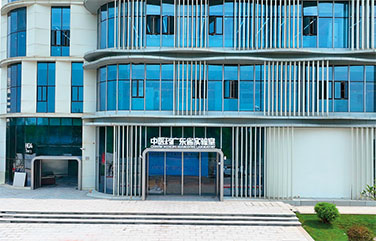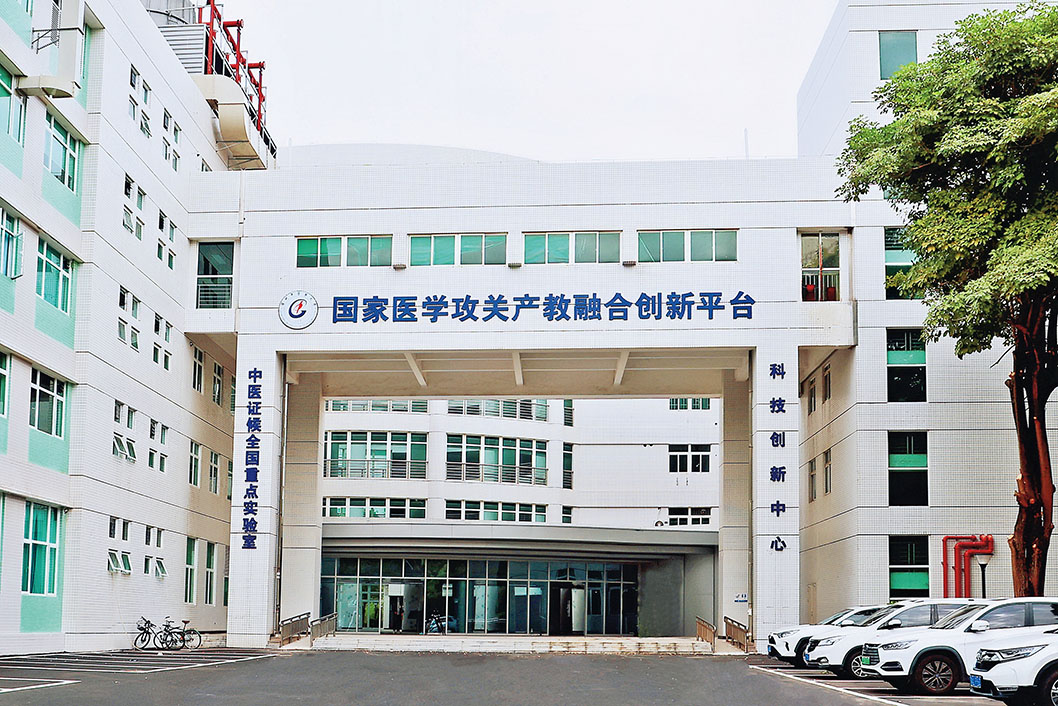The 100th Anniversary of GUCM | To Leverage the Strengths of GZUCM to Promote New Quality Productive Forces

Guangdong Laboratory ofChinese Medicine (HengqinLaboratory)
By Zhao Zhuo
Align the left eye with the camera, rotate it up, down, left, and right for the photo, then switch to the right eye. After uploading ten eye photos, a health assessment report based on big data analysis is generated in less than two minutes. This report not only predicts Chinese medicine syndromes and common diseases but also provides health management recommendations for diet, daily routines, emotional well-being, and acupuncture. On August 23, the journalist of Outlook Weekly experienced the convenience and precision of diagnosis brought about by the deep integration of traditional Chinese medicine and new technology at the Disease Prevention Center of the Second Affiliated Hospital of Guangzhou University of Chinese Medicine (GZUCM).
The Preventive Medicine Center is committed to original research and technological innovation, exploring the integration of Chinese medicine with new technologies such as the Internet of Things, big data, and artificial intelligence. It exemplifies how GZUCM and its affiliated hospitals blend traditional Chinese medicine theories with modern medicine and life sciences, fostering new quality productive forces and advancing theoretical innovation and application. This integration represents a forward-looking approach to ensuring the high-quality inheritance and development of Chinese medicine.
“Our university has established ten national research platforms, including the State Key Laboratory of Traditional Chinese Medicine Syndromes and the State Key Laboratory of Dampness Syndrome of Chinese Medicine, along with the State Innovation Platform for Medical Industry-Education Integration. It boasts 53 provincial and ministerial research platforms, such as the Guangdong Provincial Laboratory of Chinese Medicine. Over the past five years, the university has initiated more than 2,600 new vertical research projects, with nearly 600 at the national level. It has received the State Science and Technology Progress Award (Secondary Prize) and 21 provincial and ministerial science and technology awards. The university emphasizes multidisciplinary integration and is committed to advancing clinical evidence-based evaluation research of traditional Chinese medicine based on big data, digital research in CHINESE MEDICINE diagnosis and treatment, and intelligent diagnostic imaging in clinical medicine. The affiliated hospitals are developing modern diagnostic and therapeutic equipment that incorporates Chinese medicine features and clinical experience, promising to bring more innovative technologies and products to benefit patients.” said Wang Hongbin, Vice President of GZUCM.
Overcome Challenges and Build Four Major Research Platforms
In January 2021, GZUCM was approved to establish the State Key Laboratory of Dampness Syndrome of Chinese Medicine, the first national key laboratory of its kind in China. This laboratory focuses on scientific issues and common key technologies related to dampness syndromes in Chinese medicine and the prevention and treatment of major chronic diseases. It aligns with significant national health needs while embodying the regional characteristics of Guangdong.
Thanks to the relentless efforts of the research team, the laboratory has achieved remarkable results in less than four years since its establishment: a total of 273 papers published, including 195 in SCI journals, with a cumulative impact factor of 1,184.927, and 20 papers with an impact factor above 10. The lab has received 16 awards at various levels, been granted 47 patents, and led the development and issuance of 23 different standards, including 2 international and 2 national standards. Additionally, it has secured 13 copyrights/software copyrights, published 31 monographs and academic works, and transferred 6 new drugs and prescriptions, amounting to a total of RMB 173.8 million yuan.
The State Key Laboratory of Chinese Medicine Syndromes officially received approval for construction from the Ministry of Science and Technology in March 2023, making it the only state key laboratory in the field of Chinese medicine in China. The laboratory focuses on the key scientific issue of the diagnostic and therapeutic principles of the original Chinese medicine theory of “treatment based on patient differentiation”. It conducts interdisciplinary, forward-looking, integrated, and high-level applied fundamental research and technological innovation, targeting major diseases such as breast cancer, heart failure, viral pneumonia, and rheumatoid arthritis. The lab emphasizes five major tasks: the standardization and objectification of Chinese medicine syndrome diagnosis, the therapeutic principles of treating same disease with different methods and treating different diseases with same method, the scientific connotations of Chinese medicine syndromes, optimization strategies for combining Chinese medicine and Western medicine based on syndromes, and the development of prescriptions based on syndromes. It aims to create a high-end research platform for innovative integration of Chinese medicine and possesses international academic influence, as well as a national center for applied fundamental research in Chinese medicine.
Since the start of its construction, the laboratory has operated with fixed personnel as project leaders, managing a total of 63 new national-level projects. It has published 53 papers as first or corresponding author in SCI journals ranked in the first quadrant by the Chinese Academy of Sciences; secured 37 authorized invention patents; and established 10 new standards, including 2 international standards. The laboratory has also achieved 3 successful technology transfers. Among its innovations, the human magnetic induction sleep state assessment device has received a medical device registration inspection report, providing substantial support for its application in the medical field. Additionally, research projects like the Lung Protection and Treatment Granules have obtained registration approval for hospital preparations, offering more treatment options for medical institutions. In 2023, the laboratory received 6 science and technology awards, including a first prize of Guangdong Science and Technology Award.
In December 2023, Guangdong Provincial Laboratory of Chinese Medicine, primarily constructed by GUZUM and the Second Affiliated Hospital of the university (Guangdong Provincial Hospital of Chinese Medicine), officially established its presence in Hengqin. This laboratory focuses on four strategic demands: the originality of Chinese medicine theories, prevention and treatment of major diseases, the development of new drugs, and international scientific and technological competition. It conducts fundamental and applied research in five key areas: the development of Chinese medicine-based human immune defense and bio-safety products, interpretation on therapeutic principles of treatment based on patient differentiation and disease-syndrome combination, development of Chinese medicine treatment plans for common major chronic diseases, modernization of Chinese medicine diagnostic and therapeutic equipment, and the creation of new drugs.
The State Innovation Platform for Medical Industry-Education Integration is a major project launched by the National Development and Reform Commission and the Ministry of Education as part of the “14th Five-year Plan” initiative to strengthen education and support the construction of “double first-class” universities, serving the nation’s major strategic needs. At the end of 2022, the only national medical research and education-industry integration platform in Guangdong Province was officially established at GZUCM.
The platform is driven by the needs of fundamental Chinese medicine research and new drug development, focusing on resolving key technical challenges in these areas. It has established an integrated medical research and education-industry innovation platform that includes a drug target network technology platform, a big data mining technology platform, a large-scale equipment testing center, a model experimental animal center, and a comprehensive technology platform for developing classical Chinese medicine prescriptions.
Seek Quality through Innovation
On September 8, Guangzhou University of Chinese Medicine held a technology achievement showcase and project road show titled “Progress for the Centennial Celebration: Promoting Transformation through Industry-Academia Integration” at its College Town Campus. Fifteen project teams, including those led by Master of Chinese Medicine Zhou Daihan, Qihuang Scholar Dr. Lin Dingkun, Dr. Xiao Jing, Professor Song Jianping, Professor Wang Jian, Professor He Jinyang, and Professor Xu Peiping, presented high-quality results in areas such as new drug development, modern Chinese medicine diagnostic equipment, and health products.

National medical research,production and education integration innovation platform
In the area of new drug development for Chinese medicine, products developed by the university, such as Kidney Protection Pill, HeChan Tablets, Wei Nai An, Guxian Tablets, and Jinfo Pain-Killer Pill, have become core offerings of pharmaceutical companies in Guangdong and are sold nationwide. In the past five years, the hospital has successfully developed 21 new hospital prescriptions. Notably, the hospital’s Class 1 new drug, Xinyang Tablet, received the Drug Clinical Trial Approval Notice from the National Medical Products Administration in 2022. Additionally, the Second Affiliated Hospital’s Yangyin Shugan Granules were transferred in 2021 and received the Drug Clinical Trial Approval Notice in July 2023.
In addition, several new drugs, including modified formulas of Huopu Xialing Decoction and Jianer Poison-Reliving Granules, have been successfully transferred to enterprises. One standout achievement is the Fuzheng Poison-Reliving Granules, developed under the leadership of Professor Zhang Zhongde, Vice President of the university and President of the Second Affiliated Hospital. This new drug was transferred to Jiangsu Kanion Pharmaceutical Co., Ltd. for RMB 100 million yuan, providing a treatment option for deficiency syndrome and has been included in treatment protocols in multiple countries.
Continuous emergence of new products and technologies is a result of GZUCM’s long-standing commitment to enhancing the integration of industry, academia, and research, as well as its focus on improving the transformation of research outcomes.
At the same time, the university is fully leveraging the expertise of external resources by closely collaborating with national-level platforms such as the China Academy of Chinese Medical Sciences and the China Science and Technology Exchange Center. This approach brings together industry partners to build a network for facilitating technology transfer, collectively fostering the growth of the CHINESE MEDICINE intellectual property market. Additionally, the university has established partnerships with investment institutions, including the Guangzhou Angel Investment Guidance Fund, to expedite the transformation of scientific achievements, guided by the shared principles of early-stage investment, small-scale investment, and investment in hard technology.
In recent years, GZUCM has also signed agreements with more than ten local governments to co-establish industry-academia-research collaboration platforms and innovation platforms tailored to local needs, thereby nurturing and developing new quality productive forces in Chinese medicine.
“Among these achievements, more than 500 hospital presciptions produced by our university’s affiliated hospitals alone generate an annual output value exceeding RMB 300 million yuan. Our university will also integrate resources from national and provincial research platforms such as the State Innovation Platform for Medical Industry-Education Integration Innovation Platform for Medical Industry-Education Integration and the Guangdong Provincial Laboratory of Chinese Medicine. This comprehensive approach aims to fully empower Chinese medicine prescription R&D, production, and transformation, building a strong framework to forge new quality productive forces and establish a modernized industrial system.” stated Wang Hongbin, Vice President of GZUCM.
Target Strategies to Amplify the “Three-in-One” Effect
As a leading institution in the Chinese medicine field, GZUCM has consistently focused on reforming its science and technology innovation systems to maximize the multiplier effect of coordinated “Three-in-One” development. This is especially evident in the university’s deepening of talent cultivation model reforms, which unleash creative potential across various fields of expertise and drive new quality productive forces with fresh dynamics\.
“We often say that researchers are either busy applying for projects or working on project completion assessments, not to mention dealing with administrative tasks such as procurement, reimbursements, and endless forms. To improve efficiency, we must accelerate the development of a research management information system, allowing data to do the legwork and reducing the bureaucratic burden on our talent. Streamlining internal processes and speeding up approvals will help free our scientific talent from paperwork.” stated Chen Wenfeng, Secretary of the CPC?GZUCM?Committee. “Besides, we aim to enhance data sharing and communication within research teams and foster collaboration across interdisciplinary fields.”
GZUCM is also exploring a research evaluation system tailored to the characteristics of Chinese medicine, establishing a comprehensive talent assessment framework that emphasizes innovation, quality, and contribution to incentivize researchers. The recently revised Evaluation Plan for Scientific and Technological Innovation Contributions prioritizes recognition of significant scientific achievements, including high-level representative works, high-quality research projects, and impactful scientific contributions, thereby encouraging researchers to stay committed to fundamental, interdisciplinary, and emerging fields, as well as to long-term research projects.
“To promote the transformation and application of scientific and technological achievements, we have restructured the leadership group for technology transfer to ensure the Center for Technology Transfer operates as a physical entity. We have partnered with intellectual property agencies to establish a joint service platform, introduced third-party services to improve efficiency, and created a pilot platform for Chinese medicine. A transformation fund has been established to bring in social resources, and we are fostering technical management talent, creating flexible roles, and attracting corporate professionals for part-time roles. By forming collaborative innovation teams with enterprises, we are tackling technological challenges and nurturing market demand, building exchange platforms to align technology needs with supply.” said Wang Hongbin, Vice President of GZUCM.
“This year marks the university’s centennial celebration”, said Chen Wenfeng, “Both GZUCM and its affiliated hospitals are committed to participating more actively in the development of national, industry, local, and group standards as well as international standards in areas such as health services, quality improvement, high-quality industrial development, and the digitalization and intelligentization of Chinese medicine. In addition to leading Guangdong’s efforts to advance a new phase as a Chinese medicine powerhouse, we are committed to supporting the development of the Greater Bay Area as a Chinese medicine hub and serving as a model for comprehensive reform nationwide. Our goal is to accelerate the modernization, industrialization, and internationalization of Chinese medicine, contributing to high-level technological self-reliance and the construction of Chinese-style modernization.” Chen emphasized.

 手机版
手机版